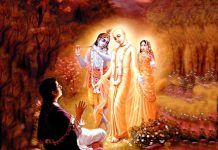Finding the ninth planet is an achievement for NASA because if what they say is true then it’s one more step closer to reality. By reality, I am referring to what is already mentioned in India’s ancient scriptures, called Vedas, since 1000s of years!
Some researchers have named this new, hidden planet as the Ninth Planet. This is specifically interesting considering there is a famous ritual in Indian scriptures called Nava-graha upasana, referring to the worship of nine planets, namely Surya (Sun), Chandra (Moon), Mangal (Marsh), Budh (Mercury), Brihaspati (Jupiter), Shukra (Venus), Shani (Saturn), Rahu and Ketu. Out of the nine, modern scientists have extensively talked about seven planets- the Sun, the Moon, Marsh, Mercury, Jupiter, Venus and Saturn, but they do not have any clue about Rahu and Ketu. It is only now that they are talking of some strange, shadowy planets in our solar system.
Sounds too religious? Don’t panic. Like it or not, being religious is just one more characteristic of human beings and we got to accept it. What is more important here is, besides the so-called Ninth planet, there are things that even scientists can learn from religious scriptures, and astronomy is one such field where they can benefit a lot from them, especially the Srimad Bhagavatam.
Let us not forget that finding the ninth planet and other potentially habitable, Earth-like planets is one of those “previously-thought” wrongs. It was only after NASA launched its infrared capable Kepler mission that they started locating what they call exoplanets, a completely new world of planets in the universe.
“The centuries-old quest for other worlds like our Earth has been rejuvenated by the intense excitement and popular interest surrounding the discovery of hundreds of planets orbiting other stars. There is now clear evidence for substantial numbers of three types of exoplanets; gas giants, hot-super-Earths in short period orbits, and ice giants. The challenge now is to find terrestrial planets (i.e., those one half to twice the size of the Earth), especially those in the habitable zone of their stars where liquid water might exist on the surface of the planet.
The Kepler Mission, NASA Discovery mission #10, is specifically designed to survey our region of the Milky Way galaxy to discover hundreds of Earth-size and smaller planets in or near the habitable zone and determine the fraction of the hundreds of billions of stars in our galaxy that might have such planets.” (Source http://www.nasa.gov/mission_pages/kepler/overview/index.html
This Milky way is described in Indian scriptures as akash ganga. We find in Srimad Bhagavatam a vivid description of stars and habitable planets. In fact it is said that there are living entities on every planets. The following sanskrit text about the Milky way sheds more light on it:
yasya pucchāgre ’vākśirasaḥ kuṇḍalī-bhūta-dehasya dhruva upakalpitas tasya lāṅgūle prajāpatir agnir indro dharma iti puccha-mūle dhātā vidhātā ca kaṭyāṁ saptarṣayaḥ; tasya dakṣiṇāvarta-kuṇḍalī-bhūta-śarīrasya yāny udagayanāni dakṣiṇa-pārśve tu nakṣatrāṇy upakalpayanti dakṣiṇāyanāni tu savye; yathā śiśumārasya kuṇḍalā-bhoga-sanniveśasya pārśvayor ubhayor apy avayavāḥ samasaṅkhyā bhavanti; pṛṣṭhe tv ajavīthī ākāśa-gaṅgā codarataḥ.
TRANSLATION: This form of the śiśumāra has its head downward and its body coiled. On the end of its tail is the planet of Dhruva, on the body of its tail are the planets of the demigods Prajāpati,Agni, Indra and Dharma, and at the base of its tail are the planets of the demigods Dhātāand Vidhātā. Where the hips might be on the śiśumāra are the seven saintly sages likeVasiṣṭha and Aṅgirā. The coiled body of the Śiśumāra-cakra turns toward its right side, on which the fourteen constellations from Abhijit to Punarvasu are located. On its left side are the fourteen stars from Puṣyā to Uttarāṣāḍhā. Thus its body is balanced because its sides are occupied by an equal number of stars. On the back of the śiśumāra is the group of stars known as Ajavīthī, and on its abdomen is the Ganges that flows in the sky [the Milky Way].
The Miky way, or akash-ganga, is also referred to elsewhere in the same book:
“The city was surrounded by trenches full of Ganges water, known as Akash-ganga, and by a high wall, which was the color of fire. Upon this wall were parapets for fighting. The doors were made of solid gold plates, and the gates were of excellent marble. These were linked by various public roads. The entire city had been constructed by Vishvakarma. The city was full of courtyards, wide roads, assembly houses, and not less than one hundred million airplanes. The crossroads were made of pearl, and there were sitting places made of diamond and coral.” (SB 8.15.14-16)
There is no harm to reiterate that it is only the lack of knowledge that modern scientists and scholars call India’s scriptures mythology. Apart from explaining the exceedingly complicated but thoroughly accurate laws of physics in great detail, these books present numerous examples of celestial events evidences of which are available even today. The books also mention how human-like beings, both from higher and lower planetary systems, visited our planet, and how sages and saintly kings from this planet visited other planets. Scripture also talk about the good and bad effects of nava-graha, or nine planets, on earthly beings, and how to deal with it. As the science advances there are chances that the so-called mythology will become known as the ultimate knowledge. After all that’s what it is.
Not only Vedic scriptures, there are other religions which also mention about more planets. There is no reason to discard the descriptions of heaven, hell and other locations mentioned in ancient scriptures. And then there are others who also claim similar things.
FoxNews Science said this while reporting on the Ninth planet:
When astronomers at the California Institute of Technology in Pasadena announced in January that they’d discovered a giant planet in our distant solar system, they ignited a frenzied debate over whether it was really out there, far beyond Neptune.
But the conversation hasn’t been limited to scientists. A separate discussion has been taking place among a passionate group of stargazers who have been looking for what they believe is the lost planet of Nibiru. For them, the discovery has raised the prospect that Nibiru –long dismissed as science fiction– has been found.
“It was very exciting to see scientists finding another planet in our solar system or evidence of it,” said Janet Sitchin, whose uncle, Zecharia Sitchin, proposed the existence of Nibiru. “It’s exciting because some of the naysayers were saying how could there be such a large body in our solar system and we don’t know about it,” She told FoxNews.com.
By the way, did you know that the names of these planets form the names of seven days of the week, i.e. Sunday, Monday, Tuesday, Wednesday, Thursday, Friday and Saturday? And have you ever thought who gave those names and why they correspond to the seven planets? If there was no advance science in the past as the modern scientists claim, how come they knew the names of the planets? Think about it and share your thoughts here.
































